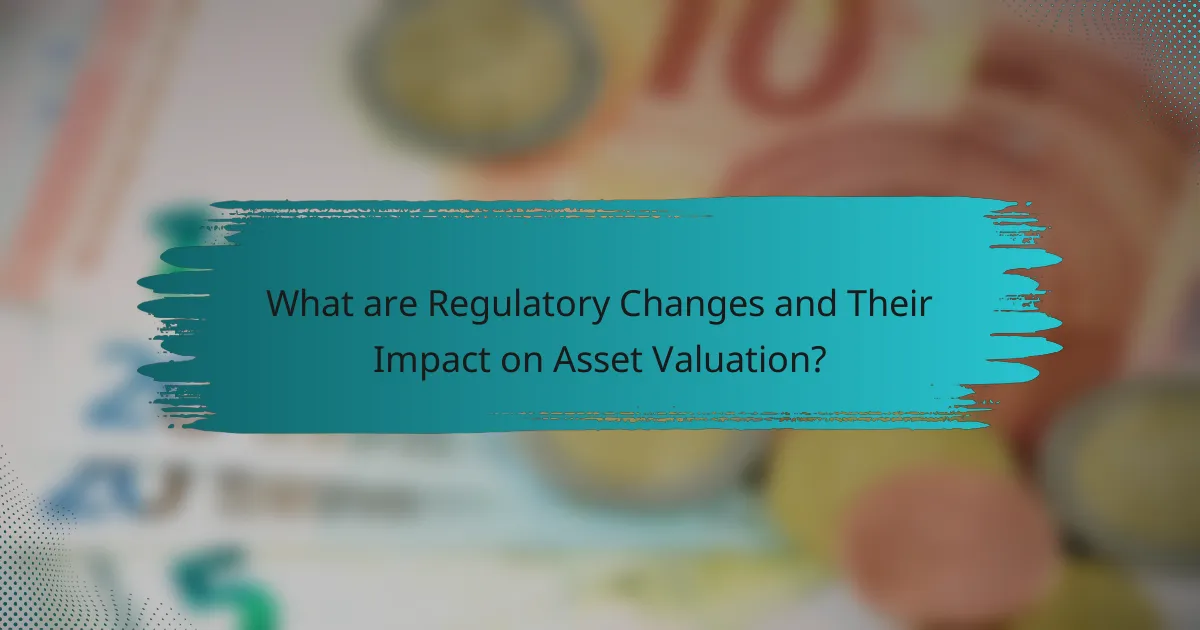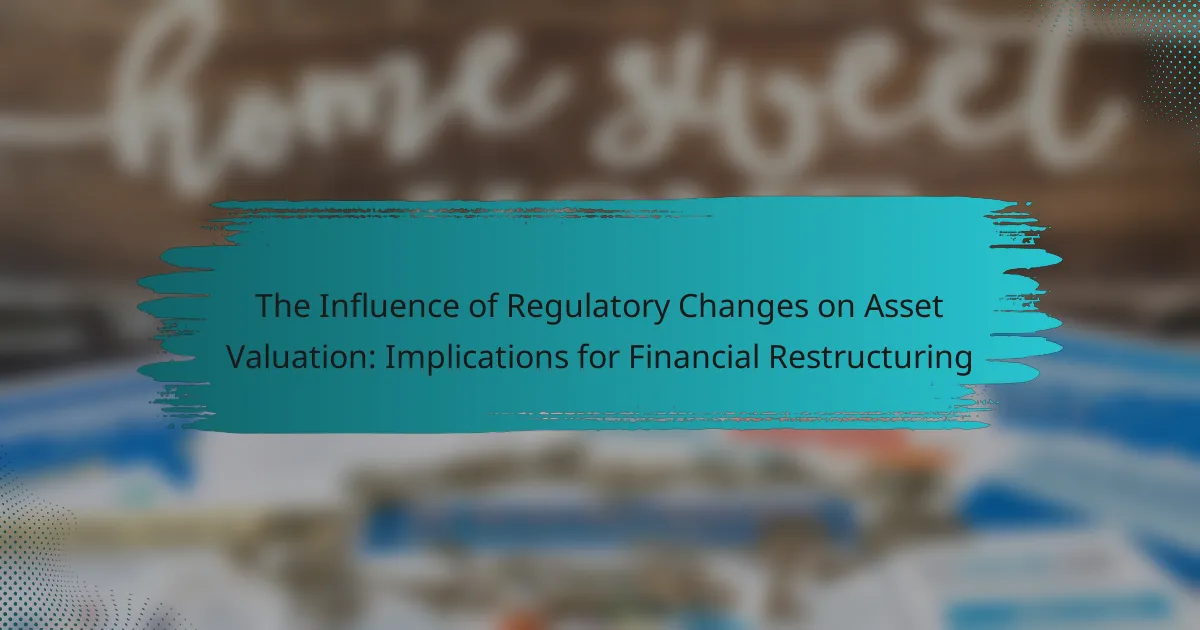Regulatory changes refer to modifications in laws or rules that govern financial markets and asset management. These changes significantly impact asset valuation by altering risk and return profiles, influencing investor expectations, and affecting compliance costs for companies. Key regulatory updates, including revisions to International Financial Reporting Standards (IFRS) and Generally Accepted Accounting Principles (GAAP), emphasize fair value measurements and enhance transparency in financial reporting. Additionally, regulatory changes can reshape financial restructuring by modifying legal frameworks and affecting debt agreements, ultimately influencing the valuation of assets and the viability of restructuring plans. This article examines the implications of regulatory changes on asset valuation and their broader effects on financial restructuring strategies.

What are Regulatory Changes and Their Impact on Asset Valuation?
Regulatory changes are modifications to laws or rules governing financial markets and asset management. They can significantly influence asset valuation by altering the risk and return profiles of investments. For instance, stricter regulations may increase compliance costs for companies, which can lower their profit margins. This often leads to a decrease in asset values as investors adjust their expectations. Conversely, deregulation can enhance market efficiency, potentially increasing asset valuations by fostering competition. Historical examples include the Sarbanes-Oxley Act of 2002, which aimed to improve corporate governance and affected stock valuations. Research shows that regulatory changes can lead to volatility in asset prices, impacting investor sentiment and market stability.
How do regulatory changes influence financial markets?
Regulatory changes influence financial markets by altering the rules and guidelines governing trading and investment practices. These changes can impact market liquidity, investor confidence, and overall economic stability. For instance, the implementation of stricter capital requirements can lead banks to reduce lending, which may slow economic growth. Conversely, deregulation can encourage investment and market activity, as seen during the repeal of the Glass-Steagall Act in 1999, which allowed commercial banks to engage in investment activities. Additionally, regulatory changes can affect asset valuations by adjusting risk perceptions among investors. The Dodd-Frank Act introduced in 2010 aimed to increase transparency and reduce systemic risk following the 2008 financial crisis, influencing how assets are valued in the wake of new compliance costs and operational adjustments. Overall, the dynamic nature of regulatory frameworks plays a crucial role in shaping market behavior and asset pricing.
What types of regulatory changes are most impactful?
Regulatory changes that are most impactful include financial regulations, environmental policies, and labor laws. Financial regulations, such as changes in capital requirements, directly affect asset valuation. For instance, the Dodd-Frank Act significantly altered banking operations and capital requirements post-2008 financial crisis. Environmental policies, like emissions regulations, influence industries reliant on fossil fuels, impacting their market value. Labor laws, including minimum wage adjustments, can affect operational costs and profitability, thus influencing asset valuations. Historical context shows that significant regulatory shifts often lead to market volatility, as seen during the implementation of the Sarbanes-Oxley Act, which transformed corporate governance.
How do these changes affect investor behavior?
Regulatory changes significantly affect investor behavior by altering risk perceptions and investment strategies. Investors may become more cautious in response to increased regulatory scrutiny. This caution can lead to a decrease in capital allocation to higher-risk assets. Conversely, regulatory changes can also create new opportunities in compliant sectors. For example, stricter environmental regulations may boost investments in green technologies. Historical data shows that regulatory shifts often lead to market volatility, prompting investors to adjust their portfolios. In 2008, regulatory changes post-financial crisis led to a flight to quality among investors, favoring safer assets. Overall, regulatory changes compel investors to reassess their risk tolerance and investment horizons.
Why is understanding asset valuation critical for financial restructuring?
Understanding asset valuation is critical for financial restructuring because it determines the true worth of an organization’s assets. Accurate asset valuation informs decision-making during the restructuring process. It helps identify which assets can be liquidated or retained to maximize value. Furthermore, it enables stakeholders to assess the financial health of the entity. Regulatory changes can impact asset valuation methods, thereby influencing restructuring strategies. For instance, shifts in accounting standards may alter how assets are reported. This can lead to different valuations and affect negotiations with creditors. Ultimately, a clear understanding of asset valuation ensures informed choices that facilitate effective financial restructuring.
What role does asset valuation play in financial stability?
Asset valuation is crucial for financial stability as it determines the worth of assets held by individuals and institutions. Accurate asset valuation allows for informed decision-making regarding investments and risk management. It influences balance sheets, affecting capital adequacy and liquidity ratios. Misvaluation can lead to financial distress, as seen in the 2008 financial crisis, where inflated asset values contributed to widespread instability. Regulatory frameworks often mandate regular valuations to ensure transparency and accountability in financial reporting. This process helps maintain market confidence and prevents systemic risks. Thus, effective asset valuation directly supports the overall health of the financial system.
How can misvaluation lead to financial distress?
Misvaluation can lead to financial distress by causing companies to overestimate or underestimate their asset values. Overvaluation may result in excessive borrowing based on inflated asset worth. This can create a cash flow mismatch when actual revenues fall short of projections. Underestimation can prompt underinvestment in critical areas, limiting growth potential. Both scenarios can lead to liquidity issues and inability to meet financial obligations. Historical data indicates that firms experiencing significant misvaluation are more likely to file for bankruptcy. Research shows that accurate asset valuation is crucial for maintaining financial health and stability.

What are the Key Regulatory Changes Affecting Asset Valuation?
Key regulatory changes affecting asset valuation include updates to International Financial Reporting Standards (IFRS) and Generally Accepted Accounting Principles (GAAP). These changes emphasize fair value measurements and require more transparency in financial reporting. The Financial Accounting Standards Board (FASB) and the International Accounting Standards Board (IASB) have introduced new guidelines. These guidelines impact how companies assess and report asset values. The changes aim to enhance comparability and reduce discrepancies in asset valuations. For instance, the introduction of IFRS 13 has standardized fair value measurement across jurisdictions. This regulation mandates detailed disclosures about the valuation techniques used. Such changes are critical for investors and stakeholders in understanding asset values accurately.
Which regulations have been recently implemented?
Recent regulations implemented include the updates to the Financial Accounting Standards Board (FASB) guidelines. These updates focus on lease accounting and revenue recognition. The changes aim to enhance transparency in financial reporting. They require companies to recognize lease liabilities on their balance sheets. Additionally, new revenue recognition standards affect how companies report income. These regulations were enacted to improve consistency and comparability in financial statements. The updates were finalized in 2021 and became effective for public companies in 2022. These regulatory changes significantly impact asset valuation and financial restructuring processes.
How do these regulations differ across industries?
Regulations differ across industries based on specific compliance requirements and operational standards. For instance, the financial services industry faces stringent regulations like the Dodd-Frank Act, which emphasizes consumer protection and financial stability. In contrast, the healthcare sector is governed by regulations such as HIPAA, focusing on patient privacy and data security. The environmental industry adheres to regulations like the Clean Air Act, aimed at reducing pollution and protecting natural resources. Each industry has unique regulatory frameworks that reflect its operational risks and societal impacts. These differences influence how companies assess asset valuation and implement financial restructuring strategies.
What is the timeline for these regulatory changes?
The timeline for these regulatory changes varies by jurisdiction and specific regulations. Generally, regulatory changes are proposed, reviewed, and finalized over a span of several months to years. For instance, in the United States, the process can take approximately 12 to 24 months from proposal to implementation. In the European Union, similar changes may require 18 to 36 months. The timeline is influenced by stakeholder feedback, legislative processes, and the complexity of the regulations. Historical examples show that significant regulatory reforms often follow this pattern.
What are the implications of these regulations on asset valuation processes?
Regulations significantly affect asset valuation processes by introducing stricter compliance standards. These standards enhance transparency and accuracy in financial reporting. As a result, organizations must adopt more rigorous valuation methodologies. This shift often leads to increased costs associated with compliance and auditing. Moreover, regulatory changes can alter market perceptions of asset values. For instance, stricter environmental regulations may reduce the valuation of assets in industries with high carbon footprints. Ultimately, these implications require firms to reassess their asset valuation strategies regularly. This ensures alignment with evolving regulatory frameworks and market expectations.
How do new compliance requirements affect valuation methodologies?
New compliance requirements significantly impact valuation methodologies. They introduce stricter criteria for assessing asset values. Valuers must now incorporate additional data and analysis into their processes. This often results in increased complexity in valuations. Compliance changes may also require adjustments in risk assessments. For instance, new regulations may mandate more rigorous due diligence. These adjustments can lead to changes in valuation outcomes. Ultimately, adherence to compliance requirements can enhance transparency and accuracy in asset valuations.
What challenges do companies face in adapting to these changes?
Companies face several challenges in adapting to regulatory changes impacting asset valuation. One significant challenge is the need for compliance with new regulations. This often requires substantial changes in internal processes and reporting practices. Companies must invest in training employees to understand these new requirements. Additionally, there may be a lack of clarity in the regulations themselves, leading to confusion and misinterpretation. Financial forecasting becomes more complex as asset valuation methods change. Companies also face increased costs associated with implementing new systems and technologies for compliance. Furthermore, adapting to these changes can lead to disruptions in business operations, affecting overall productivity. Lastly, there is the risk of penalties for non-compliance, which adds pressure to adapt swiftly and accurately.

How do Regulatory Changes Impact Financial Restructuring?
Regulatory changes significantly impact financial restructuring by altering the legal and operational frameworks within which businesses operate. These changes can affect the terms of debt agreements, influencing how companies negotiate with creditors. For instance, new regulations may impose stricter compliance requirements, which can increase the cost of capital. Additionally, regulatory changes can shift market perceptions regarding risk, altering the valuation of assets during restructuring. Historical data shows that changes in bankruptcy laws can lead to variations in recovery rates for creditors, directly influencing restructuring outcomes. Moreover, regulations related to tax treatment can affect the financial viability of restructuring plans. Overall, regulatory changes create a dynamic environment that shapes the strategies and decisions involved in financial restructuring.
What strategies can organizations adopt to navigate regulatory changes?
Organizations can adopt several strategies to navigate regulatory changes effectively. First, they should establish a dedicated compliance team. This team will monitor regulatory updates and assess their impact on operations. Next, organizations should invest in training programs for employees. Educating staff on compliance requirements is crucial for adherence.
Additionally, developing strong relationships with regulators can provide insights into forthcoming changes. Organizations should also implement flexible policies that can adapt to regulatory shifts. Regularly reviewing and updating internal processes ensures ongoing compliance.
Finally, leveraging technology can streamline compliance efforts. Automated systems can track regulatory changes and manage documentation efficiently. These strategies collectively enhance an organization’s ability to respond to regulatory changes proactively.
How can companies reassess their asset valuations post-regulation?
Companies can reassess their asset valuations post-regulation by conducting thorough evaluations of compliance impacts. They should analyze how new regulations affect asset risk profiles. This includes assessing changes in market conditions and regulatory requirements. Companies must update their financial models to reflect these new realities. Engaging with financial experts can provide insights into valuation adjustments. Additionally, companies should consider using scenario analysis to forecast potential valuation outcomes. Historical data can guide these reassessments, ensuring they remain grounded in market trends. Regular updates to asset valuations will enhance accuracy and decision-making.
What best practices should firms implement during financial restructuring?
Firms should implement a comprehensive assessment of their financial position during restructuring. This involves analyzing cash flow, liabilities, and asset values. Accurate valuation is crucial for informed decision-making. Engaging with stakeholders early is essential to ensure alignment and support. Transparent communication fosters trust and mitigates resistance. Developing a clear restructuring plan with defined milestones aids in tracking progress. Utilizing expert advisors can provide valuable insights and strategies. Regularly reviewing and adjusting the plan based on performance metrics is necessary for success. These practices enhance the likelihood of a successful financial turnaround.
What are the potential risks of ignoring regulatory changes in asset valuation?
Ignoring regulatory changes in asset valuation can lead to significant financial risks. Entities may face inaccurate asset valuations, resulting in poor decision-making. This can lead to financial losses or missed investment opportunities. Non-compliance with regulations can result in legal penalties and fines. Additionally, stakeholders may lose trust in the entity’s financial reporting. This can negatively impact the entity’s reputation and market position. Accurate asset valuation is crucial for maintaining compliance and investor confidence. Historical data shows that companies ignoring regulatory updates often face greater scrutiny from regulators and investors.
How can non-compliance affect a company’s market position?
Non-compliance can significantly weaken a company’s market position. It may lead to legal penalties, which can incur substantial financial costs. For example, companies can face fines that impact profitability. Additionally, non-compliance risks damaging a company’s reputation. A tarnished reputation can reduce consumer trust and loyalty. This can result in decreased sales and market share. Furthermore, investors may perceive non-compliance as a risk factor. This perception can lead to lower stock prices and reduced investment. In summary, non-compliance jeopardizes financial stability and competitive advantage.
What lessons can be learned from past financial restructurings?
Past financial restructurings reveal critical lessons for future practices. One key lesson is the importance of timely intervention. Delaying restructuring can lead to worsened financial conditions. Another lesson is the necessity of transparent communication with stakeholders. Clear communication fosters trust and facilitates smoother negotiations. Additionally, effective management of cash flow is vital. Companies that prioritize cash flow often navigate restructurings more successfully.
Historical examples, such as General Motors in 2009, illustrate these lessons. GM’s timely restructuring, coupled with transparent stakeholder engagement, allowed it to emerge stronger. Similarly, the 2002 restructuring of Enron emphasized the need for accurate financial reporting. Inaccurate reports hindered stakeholder trust and prolonged the process. Overall, these lessons underscore the significance of proactive management and clear communication in financial restructuring.
What practical steps can organizations take to ensure compliance and accurate asset valuation?
Organizations can ensure compliance and accurate asset valuation by implementing robust internal controls. Establishing clear policies and procedures for asset valuation is essential. Regularly training staff on compliance requirements enhances understanding and adherence. Conducting periodic audits helps identify discrepancies and areas for improvement. Utilizing standardized valuation methodologies ensures consistency and reliability in asset assessments. Engaging external experts can provide independent verification of asset values. Maintaining thorough documentation supports transparency and accountability in valuation processes. Finally, staying updated with regulatory changes is crucial for ongoing compliance and effective asset management.
The main entity of the article is regulatory changes and their impact on asset valuation within the context of financial restructuring. The article examines how modifications to laws and regulations influence asset valuation by altering risk and return profiles, affecting investor behavior, and shaping financial stability. It highlights key regulatory changes, such as the Dodd-Frank Act and updates to accounting standards, and discusses their implications for asset valuation processes and financial restructuring strategies. Additionally, the article outlines best practices for organizations to navigate these changes and emphasizes the risks associated with non-compliance.




